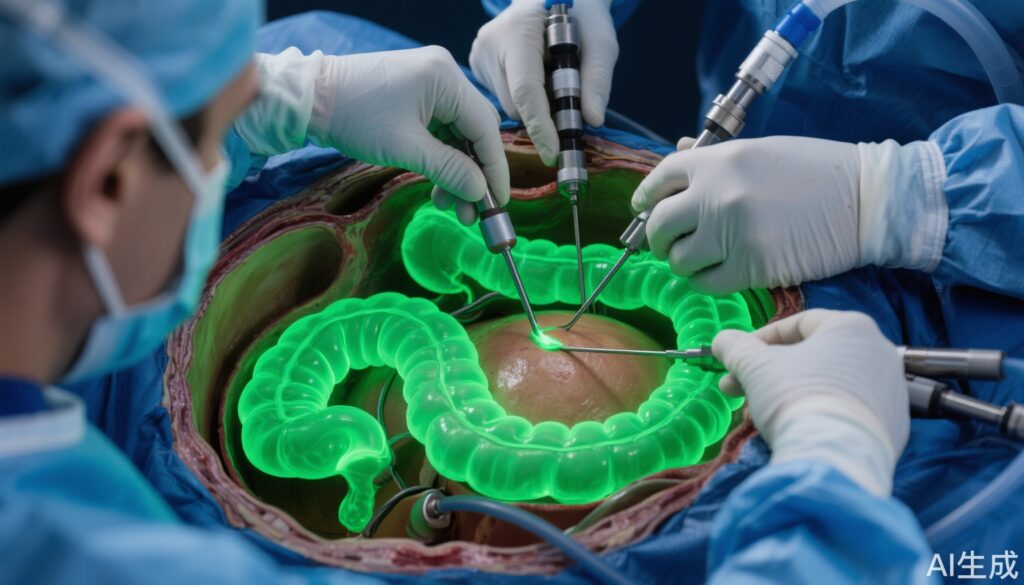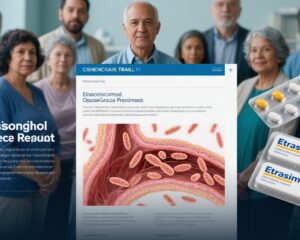Highlight
- The IntAct trial enrolled 766 patients undergoing elective laparoscopic or robotic rectal cancer surgery across 28 centers in Europe to assess if ICG fluorescence angiography reduces clinical anastomotic leaks.
- ICG fluorescence angiography showed a reduction in clinical anastomotic leaks from 15% to 10%, primarily impacting grade A and B leaks, though the difference did not reach statistical significance (p=0.087).
- No serious adverse events related to ICG were reported, indicating the safety of this imaging technique in intraoperative bowel perfusion assessment.
- Further research is needed to standardize ICG fluorescence imaging protocols and clarify its potential clinical benefits.
Study Background and Disease Burden
Anastomotic leak is a serious postoperative complication following rectal cancer surgery, associated with increased morbidity, mortality, prolonged hospitalization, and impaired oncological outcomes. Despite advances in surgical techniques, anastomotic leak rates remain high, ranging up to 15% in many series. Ensuring adequate blood supply to the anastomosis is critical to prevent leaks. However, clinical assessment of bowel perfusion under standard white light is subjective and unreliable.
Indocyanine green (ICG) fluorescence angiography enables real-time visualization of microvascular perfusion at the surgical site. While observational studies have shown promising reductions in leak rates, randomized controlled trial data are mixed and insufficient, especially in rectal cancer surgery. The IntAct trial was designed to rigorously assess the safety and efficacy of intraoperative ICG fluorescence angiography in reducing clinical anastomotic leaks after elective anterior resection for rectal cancer.
Study Design
IntAct was a prospective, unblinded, multicenter randomized controlled trial conducted at 28 specialized rectal cancer centers across eight European countries. Adults aged 18 years or older diagnosed with rectal cancer (tumor ≤15 cm from the anal verge) and fit for elective, curative laparoscopic or robotic anterior resection were eligible.
Participants were randomly allocated 1:1 to receive surgery with or without intraoperative ICG fluorescence angiography. In the ICG group, surgeons first marked the proximal bowel transection level under standard white-light laparoscopy, then administered an intravenous bolus of ICG (0.1 mg/kg) for perfusion assessment prior to transection, with a second ICG dose used post-anastomosis to reassess blood flow. The control group underwent standard white-light perfusion evaluation only.
The primary endpoint was the incidence of clinical anastomotic leaks classified as grades B or C by the International Study Group of Rectal Cancer within 90 postoperative days. Secondary endpoints included grade A leaks, safety, and adverse events related to ICG.
Key Findings
Out of 2,534 patients screened, 766 were randomized equally between the ICG and standard care groups. The median age was 64 years, and 65% of participants were male. Most participants (95%) were White.
In the intention-to-treat analysis (n=698), clinical anastomotic leaks occurred in 13% overall. Grade A leak rates were 3% in the ICG group vs. 6% in controls. Grade B leaks were 3% vs. 9%, and grade C leaks were 7% vs. 6%, respectively. The overall clinical leak rate (grades B and C) was 10% in the ICG group versus 15% in the standard care group, corresponding to an adjusted odds ratio of 0.667 (95% CI 0.419–1.060; p=0.087), indicating a trend toward benefit without statistical significance.
No serious adverse events attributable to ICG administration were reported, supporting the technique’s safety profile. The similarity in grade C leak rates suggests that ICG fluorescence angiography may primarily help prevent milder leaks (grades A and B) rather than severe leaks requiring surgical intervention.
Expert Commentary
The IntAct trial provides the most extensive randomized evidence to date on intraoperative ICG fluorescence angiography in rectal cancer surgery. Though it did not meet statistical significance for its primary endpoint, the observed trend toward leak reduction aligns with smaller observational studies and meta-analyses. Importantly, the trial underscores that ICG is safe and feasible in routine surgical practice.
Limitations include the unblinded design, potential variability in surgeons’ interpretation of fluorescence, and lack of standardized perfusion assessment criteria. The findings highlight the need for developing objective fluorescence quantification methods and consensus guidelines to optimize clinical decision-making.
Given the devastating consequences of anastomotic leaks, incorporating ICG fluorescence angiography as an adjunct to standard assessment may confer clinical benefit, particularly in preventing minor leaks that increase morbidity and healthcare costs. Future multicenter trials with standardized imaging protocols and exploration of fluorescence intensity thresholds could clarify its role further.
Conclusion
IntAct demonstrates that intraoperative ICG fluorescence angiography is a safe technique with a potential trend towards reducing clinical anastomotic leaks after rectal cancer surgery, especially milder grades of leak. Although results did not achieve statistical significance, the findings warrant cautious optimism and encourage further research to standardize fluorescence assessment and confirm clinical benefit. This study contributes valuable evidence guiding surgeons on the integration of fluorescence imaging technology in colorectal surgery to improve patient outcomes.
References
Jayne D, Croft J, Corrigan N, Quirke P, Cahill RA, Ainsworth G, Meads DM, Kirby A, Tolan D, Gordon K, Hompes R, Spinelli A, Foppa C, Wolthuis AM, D’Hoore A, Vignali A, Tilney HS, Moriarty C, Vargas-Palacios A, Young C, Kelly R, Stocken D; IntAct Collaborative Group. Intraoperative fluorescence angiography with indocyanine green to prevent anastomotic leak in rectal cancer surgery (IntAct): an unblinded randomised controlled trial. Lancet Gastroenterol Hepatol. 2025 Sep;10(9):806-817. doi: 10.1016/S2468-1253(25)00101-3. Epub 2025 Jul 18. PMID: 40690925.


